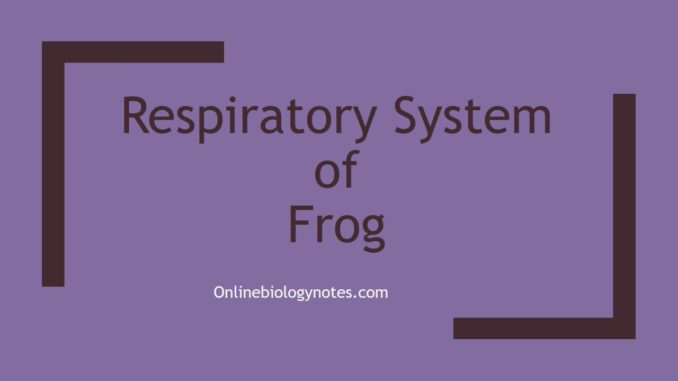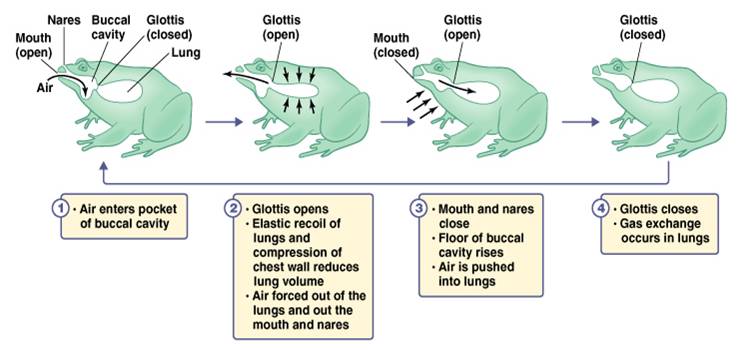
How Frog breathe?
- Respiratory system is comprised of the organs that help in the intake and supply of oxygen to the tissues as well as to get rid of excess carbon dioxide.
- Branchial respiration occurs in case of tadpoles or larval stage.
- Branchial respiration takes place by means of external gills.
- Respiration in adult frog occurs through 3 different ways:
- Cutaneous respiration: It takes place through moist surface of outer skin.
- Buccal respiration: It takes place through lining of bucco-pharyngeal cavity.
- Pulmonary respiration: It takes place through lungs.
- In each of the above cases, there are numerous blood capillaries lying close to the epithelium.
- Through these capillaries, the incoming O2 and outgoing CO2 diffuse readily.

i. Cutaneous respiration in frog:
- Cutaneous respiration takes place all the time, whether frog is in or out of water.
- When the frog is under water or hibernating, it is the only mode of respiration.
- There is rich supply of blood in the skin and it is permeable to gases.
- Oxygen must first dissolve in a moist surface before it diffuses into blood.
- This is also one of the reasons for frogs to stay near water and keep their skin moist.
- The mucus glands also secrete mucus so that the skin doesn’t dry out of water.
- Movement is not required in cutaneous respiration as skin remains exposed to air or water.
ii. Buccal respiration in frog:
- In buccal respiration on land, the mouth stays permanently closed while the nostrils remain open.
- The floor of the buccal cavity is alternately raised and lowered.
- It allows the air to be drawn into and expelled out of the buccal cavity repeatedly through the open nostrils.
- The glottis remains closed during buccal respiration. It is done so that no air enters or leaves the lungs into buccal cavity.
- The mucus epithelial lining of buccal cavity is rich in blood capillaries which absorbs O2 in the air and gives out CO2.
iii. Pulmonary respiration and sound production in frog:
- The breathing that takes place on land in the atmospheric air by the help of lungs is termed as pulmonary respiration.
- In case of frogs, the lungs are poorly developed.
- Thus, the insufficient supply of O2 obtained through lungs is supplemented by the moist skin and buccal cavity.
Respiratory Organs of frog:
- The main organs for aerial respiration are the two lungs.
- The passage through which the air enters and leaves the lungs is termed as respiratory tract.
- Respiratory tract; It consists of:
- External nostrils
- Internal nostrils
- Nasal chambers
- Bucco-pharyngeal cavity
- Glottis
- Laryngo-tracheal chamber
- Two bronchi
- On the floor of pharynx, the median slit-like glottis is present.
- Glottis opens into larynx. Larynx or laryngo-tracheal chamber is a thin walled chamber.
- Cartilages (2 arytenoid + 1 cricoid) support the walls of larynx.
- Its internal lining forms a pair of elastic horizontal bands, the vocal cords.
- Vocal cords are for sound production thus larynx is also called as voice box.
- The characteristic croaking is produced because of the vibrations formed when the air from lungs is forced outside.
- The tension of the cords can be changed by special muscles, hence, changing the pitch of the sound.
- Only male frogs have vocal sacs so as to amplify the croaking sound.
- From larynx, bronchus leads to each lung.
- Bronchus is a very small tube.
- Lungs:
- Lungs are ovoid in structure.
- They are thin-walled and highly elastic sacs.
- They are suspended freely inside the peritoneal body cavity, one on either side of the heart.
- Peritoneum covers the lung externally.
- The inner surface of each lung is divided by septa (a network of folds) into many small air sacs or alveoli, leaving a clear large central cavity.
- The alveoli are lined by thin epithelium.
- This epithelium is richly supplied with blood capillaries that contains de-oxygenated blood for gaseous exchange.
- O2 in the inhaled air diffused to blood whereas CO2 is released into alveoli.
Mechanism of Respiration in frog:
- Pulmonary respiration occurs in between buccal respiration.
- Here, buccal cavity acts as a force pump.
- The action of two special sets of muscles brings the rhythmic up and down movements of the floor of buccal cavity.
- Sternohyal muscles:
- These muscles are attached at the lower end to the sternum and at the upper end to the undersurface of cartilaginous hyoid apparatus embedded in the floor of buccal cavity.
- Pterohyal muscles:
- These muscles are attached below to the upper surface of hyoid apparatus and above to the squamosal bone of skull.
- The whole respiratory mechanism involves two phases:
Inspiration:
- The frog closes its glottis and mouth while drawing air into the lungs.
- In this phase, nostrils remain open.
- Now, the sternohyal muscles contract.
- This contraction allows the hyoid apparatus and the floor of buccal cavity to be lowered.
- The buccal cavity is enlarged and the air is drawn into the buccal cavity through the nostrils.
- Now, the glottis opens and the mentomeckalian bones of lower jaw push upwards the premaxillae bones of upper jaw. This closes the nostrils.
- Then, the pterohyal muscles contracts which raises the hyoid apparatus and the floor of buccal cavity.
- The reduction in volume of buccal cavity forces the compressed air through the opened glottis into the two lungs.
- This process by which lungs are filled with air is called inspiration.
Expiration:
- The glottis closes when lungs are filled with air.
- For some time, air is held in the lungs during which buccal floor is repeatedly raised and lowered to carry on buccal respiration.
- Soon, the glottis opens.
- The air in the lungs are driven out into the buccal cavity by lowering its floor.
- It is aided by the elasticity of lungs and contraction of the body muscles.
- The glottis closes when the buccal floor is raised again.
- Now, the air is expelled through the opened nostrils to outside.
- This process by which the lungs are emptied is called expiration.
